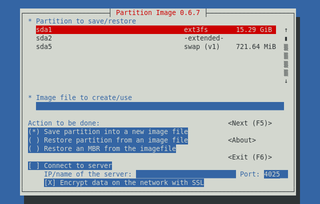In object-oriented programming, a class is an extensible program-code-template for creating objects, providing initial values for state and implementations of behavior.
Zope is a family of free and open-source web application servers written in Python, and their associated online community. Zope stands for "Z Object Publishing Environment", and was the first system using the now common object publishing methodology for the Web. Zope has been called a Python killer app, an application that helped put Python in the spotlight.
Smarty is a web template system written in PHP. Smarty is primarily promoted as a tool for separation of concerns. Smarty is intended to simplify compartmentalization, allowing the front-end of a web page to change separately from its back-end. Ideally, this lowers costs and minimizes the efforts associated with software maintenance.

PyGTK is a set of Python wrappers for the GTK graphical user interface library. PyGTK is free software and licensed under the LGPL. It is analogous to PyQt/PySide and wxPython, the Python wrappers for Qt and wxWidgets, respectively. Its original author is GNOME developer James Henstridge. There are six people in the core development team, with various other people who have submitted patches and bug reports. PyGTK has been selected as the environment of choice for applications running on One Laptop Per Child systems.
Pygame is a cross-platform set of Python modules designed for writing video games. It includes computer graphics and sound libraries designed to be used with the Python programming language.
A web content management system is a software content management system (CMS) specifically for web content. It provides website authoring, collaboration, and administration tools that help users with little knowledge of web programming languages or markup languages create and manage website content. A WCMS provides the foundation for collaboration, providing users the ability to manage documents and output for multiple author editing and participation. Most systems use a content repository or a database to store page content, metadata, and other information assets the system needs.
CherryPy is an object-oriented web application framework using the Python programming language. It is designed for rapid development of web applications by wrapping the HTTP protocol but stays at a low level and does not offer much more than what is defined in RFC 7231.

Django is a free and open-source, Python-based web framework that runs on a web server. It follows the model–template–views (MTV) architectural pattern. It is maintained by the Django Software Foundation (DSF), an independent organization established in the US as a 501(c)(3) non-profit.

TurboGears is a Python web application framework consisting of several WSGI components such as WebOb, SQLAlchemy, Kajiki template language and Repoze.

A web template system in web publishing allows web designers and developers work with web templates to automatically generate custom web pages, such as the results from a search. This reuses static web page elements while defining dynamic elements based on web request parameters. Web templates support static content, providing basic structure and appearance. Developers can implement templates from content management systems, web application frameworks, and HTML editors.
Scaffolding, as used in computing, refers to one of two techniques:

Newt is a programming library for color text mode, widget-based user interfaces. Newt can be used to add stacked windows, entry widgets, checkboxes, radio buttons, labels, plain text fields, scrollbars, etc., to text user interfaces. This package also contains the shared library needed by programs built with newt, as well as a CLI application whiptail, which provides the most commonly used features of dialog. Newt is based on the slang library. It abbreviates from Not Erik's Windowing Toolkit.

A template processor is software designed to combine templates with a data model to produce result documents. The language that the templates are written in is known as a template language or templating language. For purposes of this article, a result document is any kind of formatted output, including documents, web pages, or source code, either in whole or in fragments. A template engine is ordinarily included as a part of a web template system or application framework, and may be used also as a preprocessor or filter.
Genshi is a template engine for XML-based vocabularies written in Python. Genshi is used to easily insert generated output into XML-based languages, usually HTML, and reuse elements between documents. Genshi's syntax is based on Kid, but its architecture is different. Genshi aims to implement some of its functionality while processing templates faster, by dynamically processing templates using a stream based API, instead of compiling templates to Python code.
Haml is a templating system that is designed to avoid writing inline code in a web document and make the HTML cleaner. Haml gives you the flexibility to have some dynamic content in HTML. Similar to other template systems like eRuby, Haml also embeds some code that gets executed during runtime and generates HTML code in order to provide some dynamic content. In order to run Haml code, files need to have a .haml extension. These files are similar to .erb or .eRuby files, which also help embed Ruby code while developing a web application.
Web2py is an open-source web application framework written in the Python programming language. Web2py allows web developers to program dynamic web content using Python. Web2py is designed to help reduce tedious web development tasks, such as developing web forms from scratch, although a web developer may build a form from scratch if required.
The Wing Python IDE is a family of integrated development environments (IDEs) from Wingware created specifically for the Python programming language, with support for editing, testing, debugging, inspecting/browsing, and error checking Python code.
The following outline is provided as an overview of and topical guide to the Perl programming language:
ProcessWire is a free and open source content management system (CMS), content management framework (CMF) and web application framework (WAF) written in the PHP programming language. It is distributed under the Mozilla Public License 2.0. ProcessWire is built around an API with usage and naming conventions similar to the JavaScript framework jQuery. The stated goal behind the API is to provide the level of accessibility and control to pages in a website that jQuery provides to the DOM. Content is managed either via the API or the web-based admin control panel. ProcessWire is largely used for development of web sites, web applications, services, content feeds and related applications.





